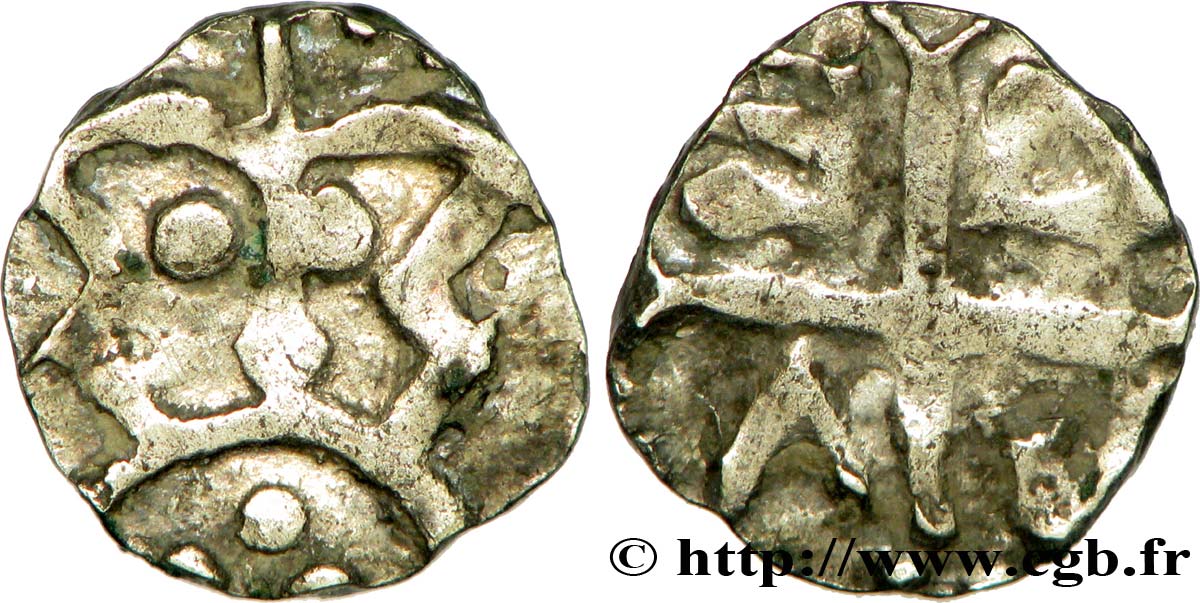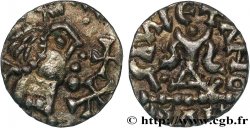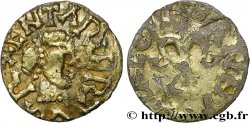v38_1687 - MONETE DELLO MEROVINGI - BANASSAC (BANNACIACO) - Lozere Denier
MONNAIES 38 (2009)
起拍价 : 350.00 €
估价 : 500.00 €
竞价记录 : 410.00 €
出价数量 : 4
最高出价 : 560.00 €
起拍价 : 350.00 €
估价 : 500.00 €
竞价记录 : 410.00 €
出价数量 : 4
最高出价 : 560.00 €
种类 Denier
日期: (VII-VIIIe siècles)
铸币厂名称/城市 Banassac
材质 silver
直径 12 mm
模子方针 12 h.
重量 1,43 g.
稀少度 R3
关于品相的说明
Denier sur un flan épais et régulier, presque rond, de poids particulièrement lourd ! Frappe centrée et vigoureuse des deux côtés. Patine grise plus ou moins homogène avec de petites concrétions de surface
出版目录中的项代码 :
正面
正面的说明书 Calice à deux anses ou mitre stylisée (?), surmonté d’une croisette et surmontant trois annelets posés en triangle.
背面
背面的文字 E - D - A - Z.
背面的说明书 Croix aux bras bifides, une lettre dans chaque canton.
评论
Le calice, typique du monnayage d’argent de Banassac, est différent sur ce denier par rapport à ceux du Belfort, par exemple. Pour ce type, toutes variétés confondues, G. Depeyot n’a répertorié que neuf exemplaires ; les trois du Belfort, trois de la vente Cahn 1932, deux du trésor de Saint-Pierre-les Etieux et un du trésor de Bais. Un dixième exemplaire est aussi classé à Banassac à cause du calice, mais d’un tout autre type (cf. B. 5757).
Au revers, les lettres A et Z sont relativement nettes dans les 3e et 4e cantons de la croix, mais les lettres dans les deux premiers cantons sont difficiles à identifier. D’après les monnaies n° 774 à 777 du Belfort, il devrait s’agir de RA-G ou LA. Les lettres RAG ont fait attribuer ces deniers à Ragenfrid, mais A. de Belfort les restitue à Banassac en raison des analogies avec les monnaies d’or au calice.
Seulement sur l’exemplaire proposé ici, l’analogie n’est pas du tout évidente et les lettres semblent plutôt être E (rétrograde) au premier canton et D au deuxième canton !
Bien qu’aucune autre monnaie d’argent s’en approchant ne semble être publiée, il est permis de douter de la parenté de ce denier avec les monnaies traditionnellement attribuées à Banassac ?.
Au revers, les lettres A et Z sont relativement nettes dans les 3e et 4e cantons de la croix, mais les lettres dans les deux premiers cantons sont difficiles à identifier. D’après les monnaies n° 774 à 777 du Belfort, il devrait s’agir de RA-G ou LA. Les lettres RAG ont fait attribuer ces deniers à Ragenfrid, mais A. de Belfort les restitue à Banassac en raison des analogies avec les monnaies d’or au calice.
Seulement sur l’exemplaire proposé ici, l’analogie n’est pas du tout évidente et les lettres semblent plutôt être E (rétrograde) au premier canton et D au deuxième canton !
Bien qu’aucune autre monnaie d’argent s’en approchant ne semble être publiée, il est permis de douter de la parenté de ce denier avec les monnaies traditionnellement attribuées à Banassac ?.








 对产品描述纠错
对产品描述纠错 打印
打印 分享我的选择
分享我的选择 提问
提问 Consign / sell
Consign / sell
 产品介绍
产品介绍